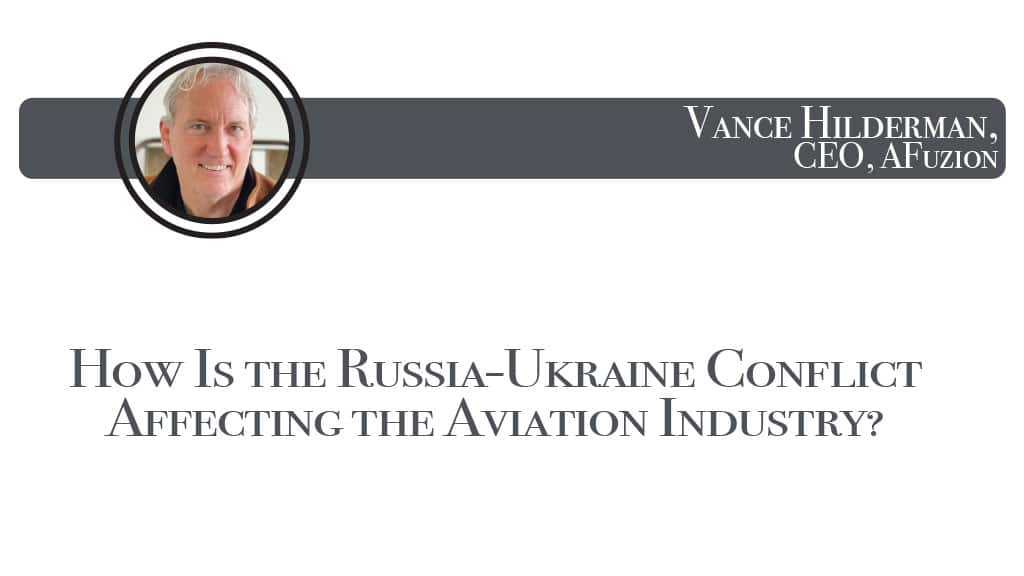Vance Hilderman is the principal founder/CTO of three aviation development/certification companies including TekSci, HighRely, and AFuzion. Hilderman has trained more than 31,000 engineers in more than 700 aviation companies and 30+ countries. His intellectual property is in use by 70% of the world’s top 300 aviation and systems developers worldwide, and he has employed and personally presided over 500 of the world’s foremost aviation engineers on 300+ projects the past 35 years. AFuzion’s solutions are on 90% of the aircraft developed over the past three decades. His latest book, “Aviation Development Ecosystem,” debuted at #1 on the Aviation category bestseller list.
As the conflict between Ukraine and Russia escalates, the effects of the fighting are rippling across financial markets and causing immediate disruptions in a host of industries. And the already weakened aviation industry is taking on additional losses, compounding the negative effects of the COVID pandemic. Thousands of international flights are being diverted and flight paths entirely reshaped as countries close their air space in response to the conflict.
Regardless of how long the dispute lasts, the effects on the aviation industry are likely to be substantial. The United Kingdom and the European Union have banned all Russian airplanes from operating in their respective airspaces, and Russia in return has closed off its airspace to carriers from 36 countries, including all 27 EU member countries.
As a result, we’re seeing a return to the longer and less efficient flight of the Cold War era, when carriers had to entirely avoid the USSR and much of the Eastern bloc.
Adding another blow to the aviation industry, oil prices have surged above $100 a barrel due to a mix of speculation, supply-chain disruptions, and trading embargos.
There may, however, be an upside to all this disruption. Although the conflict has had significant repercussions for passengers and airlines, it also opens up the possibility for transformation, encouraging the aviation industry to pursue a much-needed revitalization. As oil prices continue to rise, and consumers balk at ticket prices tied to the cost of a fickle and unsustainable fuel source, there will likely be renewed interest in electric aircraft.
Raising the Cost of Flying
In response to the current conflict, airlines have had to cancel a multitude of flights to avoid flying over the conflict zones and must now take less economically efficient routes, expending more fuel at a higher price. Long-haul European carriers destined for Asia must now traverse the Arctic Circle and head west instead, adding 1,500 to 2,000 miles to the journey from London to Tokyo.
And since airlines need to pay countries to use their airspace, the airlines will need to renegotiate agreements based on the flight path changes.
All of these costs will inevitably have an enormous impact on ticket prices, which could, in turn, discourage passengers from flying, just as the industry was starting to recover from the devastating economic effects of COVID.
The Russia-Ukraine conflict is also having a significant effect on supply chains. Similar to the airline industry, cargo ships have seen their routes disrupted, causing them to expend more fuel on longer trips, as well as interrupting the delivery of that fuel to the countries that need it.
What’s more, diminished trade caused by embargos will also negatively affect aviation supply chains. For instance, Boeing and Airbus both source the bulk of their titanium from Russia. So, not only will a prolonged conflict divert flight paths and increase costs, but it will also cause delays in the development and production of the planes themselves.
Lessening Dependence on Oil
The silver lining here is that the current predicament may actually push the industry to diversify its oil-dependent fleet. As the war continues, it may finally be time for the aviation industry to move past its own Cold War relics and start adopting vehicles that are more sustainable. Despite decades of consumer, scientist, and policymaker demand, the process of developing greener alternatives in the airline industry has been decidedly slow.
Fortunately, there’s eVTOL. The Electric Vertical Take-Off & Landing (eVTOL) aircraft is rapidly emerging as the aviation technology to watch and invest in. This machinery uses electric power to take off, hover, and land vertically. While the technology works, the certification process has at times proven painfully bureaucratic and has hindered progress.
More than 240 eVTOL aircraft programs are underway today. Billions of dollars have gone into testing eVTOL technology, and it has undergone a successful pilot program. A flurry of new investments is likely to come soon, as the world tires of its dependence on oil-fueled passenger planes.
The first all-electric passenger airplane, Alice, is now set to take off within the next few weeks, pioneering in a new era of uncertainty but also of innovation, perhaps one in which we can move beyond dependence on an unsustainable resource that is inseparable from global conflicts.
